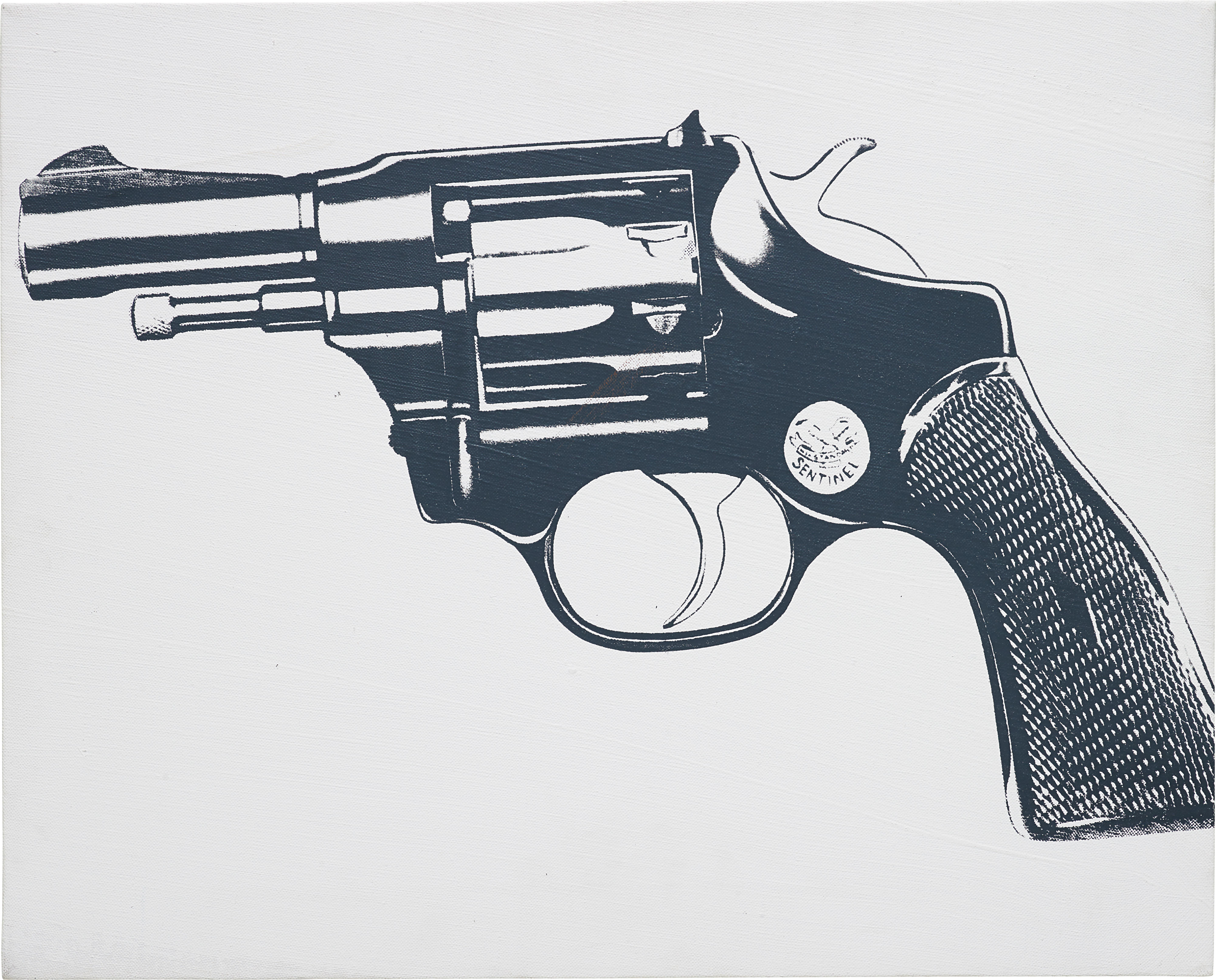

32
Andy Warhol
Gun
Full-Cataloguing
The present lots date from 1981-82, a twilight period in which Warhol returned to and reexamined the key images of his career. His Guns and Knives series have both frequently been read as holding autobiographical significance: stark still lives that allow a therapeutic reconciliation with violence through the impersonal and studied superficiality of Warhol’s image-making practice. As his friend Vincent Fremont recounts, ‘having nearly been killed by a handgun Andy was able to make paintings of guns as iconic objects. In order to choose which guns he would use we made calls to friends who might know someone with a gun. A few scary people, with first names only, came by and let Andy take Polaroids of their weapons. I remember him photographing a sawn-off shotgun. Finally after looking at the different Polaroids, he decided to use high-contrast reproductions of certain handguns.’ (Vincent Fremont, Cast a Cold Eye: The Late Work of Andy Warhol, New York, NY: Gagosian, 2006, p.157).
Through his trademark serial production methods Warhol reclaims and distances himself from the very weapon which nearly claimed his life. Devoid of personality, the gun becomes a clinical object: reiterated icon rather than loaded firearm. Unlike Roy Lichtenstein’s 1963 Trigger Finger, which fetishizes the gun at the point of firing, Warhol’s guns are inert, distanced from human contact and displayed like laboratory specimens.
This dispassionate Warholian lens elides the intense physical agony that birthed the series. The artist recounted the Solanas incident in harrowing detail: ‘as I was putting the phone down, I heard a loud exploding noise and whirled around: I saw Valerie pointing a gun at me and I realized she'd just fired it. I said “No! No, Valerie! Don't do it!” and she shot at me again. I dropped down to the floor as if I'd been hit, I didn't know if I actually was or not. I tried to crawl under the desk. She moved in closer, fired again, and then I felt horrible, horrible pain, like a cherry bomb exploding inside me.’ (Andy Warhol in Andy Warhol and Pat Hackett, POPism: The Warhol Sixties, Orlando: Harcourt Press, 1980, p.343). Warhol was forced to undergo invasive surgery, his chest opened and heart massaged; he suffered ongoing pain and wore a surgical corset for the rest of his life.
As the pistols are emptied of murderous intent, Warhol achieves catharsis through postmodern praxis that is predicated on a deep understanding of the mass media cult of the image. Warhol wrote in 1980 that ‘The more you look at the same exact thing, the more the meaning goes away and the better and emptier you feel.’ (Andy Warhol in Andy Warhol and Pat Hackett, POPism: The Warhol Sixties, Orlando: Harcourt Press, 1980, p.50). A year later, the French theorist Baudrillard observed that ‘We live in a world where there is more and more information, and less and less meaning.’ (Jean Baudrillard, Simulacra and Simulacrum, Paris: Editions Galilée, 1981, p.79). Warhol finds solace in this very condition, attaining a sort of nirvana through surface.
Baudrillard advances his diagnosis of the ‘hyperreal’ in an exegesis of ‘the "TV" image, which suggests nothing, which mesmerizes, which itself is nothing but a screen, not even that … you are the screen, and the TV watches you.’ (Jean Baudrillard, Simulacra and Simulacrum, Paris: Editions Galilée, 1981, p.53). The crucial distinctions between the real and the virtual, he argues, have now all but disappeared. Again, this theory of contemporary perception finds a striking equivalence in the tenor of Warhol’s own outlook on life: one punctuated decisively by the shooting. ‘Before I was shot, I always thought that I was more half-there than all-there – I always suspected that I was watching TV instead of living life. People sometimes say that the way things happen in movies is unreal, but actually it's the way things happen in life that's unreal. The movies make emotions look so strong and real, whereas when things really do happen to you, it's like watching television – you don't feel anything. Right when I was being shot and ever since, I knew that I was watching television. The channels switch, but it's all television.’ (Andy Warhol, The Philosophy of Andy Warhol (From A to B and Back Again), San Diego: Harvest, 1977, p.91).
Unreality reigns anaesthetic in the gleaming barrels of these guns, embodying a pivotal moment in the artist’s long-running engagement with morbidity. From the Death and Disaster series to the Skulls of 1976, Warhol is a decidedly macabre printmaker. In the monochrome emblems of the present lots, he sidesteps the bodily; deathly forms are polished, aestheticized almost to the point of abstraction, a violent symbol of all-American freedom emptied of trauma. In typically oblique mode, Warhol deadpanned ‘I’m doing knives and guns. Just making abstract shapes out them.’ (Andy Warhol in Barry Blinderman, ‘Modern Myths: Andy Warhol’ in Kenneth Goldsmith (ed.), I’ll Be Your Mirror: The Selected Andy Warhol Interviews 1962-1987, Boston, MA: De Capo Press, 2009, p.299).
Andy Warhol
American | B. 1928 D. 1987Andy Warhol was the leading exponent of the Pop Art movement in the U.S. in the 1960s. Following an early career as a commercial illustrator, Warhol achieved fame with his revolutionary series of silkscreened prints and paintings of familiar objects, such as Campbell's soup tins, and celebrities, such as Marilyn Monroe. Obsessed with popular culture, celebrity and advertising, Warhol created his slick, seemingly mass-produced images of everyday subject matter from his famed Factory studio in New York City. His use of mechanical methods of reproduction, notably the commercial technique of silk screening, wholly revolutionized art-making.
Working as an artist, but also director and producer, Warhol produced a number of avant-garde films in addition to managing the experimental rock band The Velvet Underground and founding Interview magazine. A central figure in the New York art scene until his untimely death in 1987, Warhol was notably also a mentor to such artists as Keith Haring and Jean-Michel Basquiat.